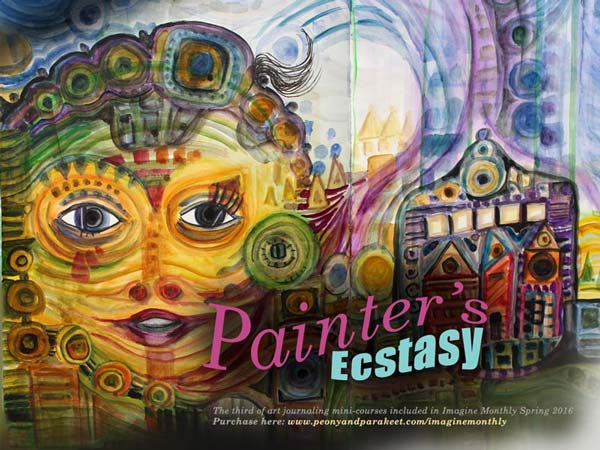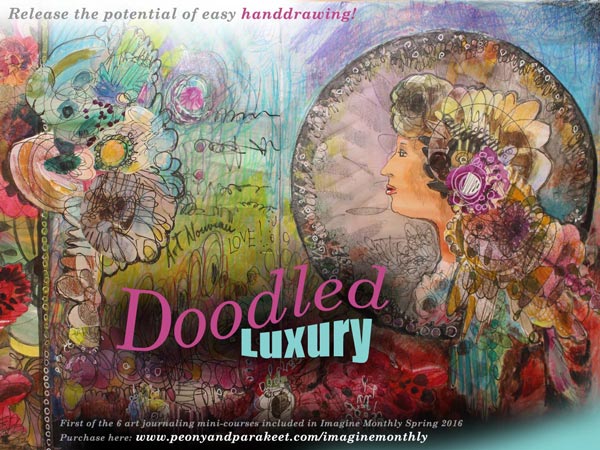Monet’s World of Energy
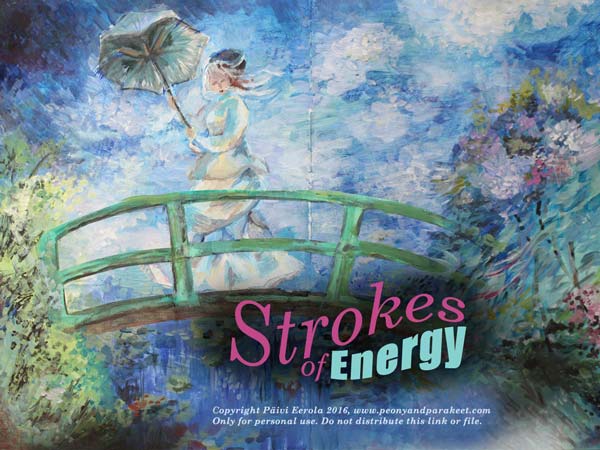
The famous impressionistic painter Claude Monet inspired me to creates this art journaling mini-course. Strokes of Energy has just been released as a part of Imagine Monthly.
Calmness vs. Energy
When I examined Monet’s painting style, I spent a lot of time with calming blues and greens.
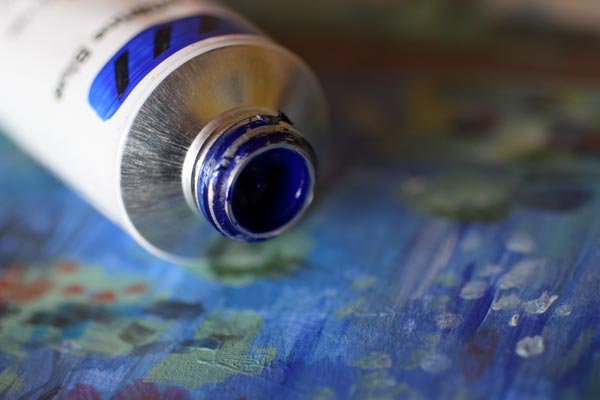
But the more I painted, the more I brought energy into the painting. Even if you feel calm when watching Monet’s paintings, his painting style is much more than just lightly caressing the canvas. Directional strokes and plenty of colors are essential in Monet’s impressionistic style. The most fun part of using the active energy is creating all the juicy details with short strokes of paint.
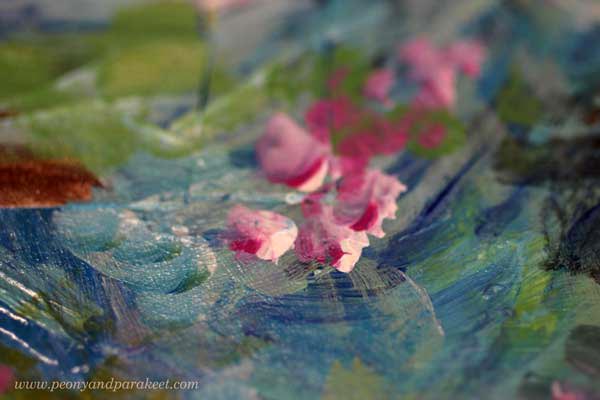
Monet’s Fresh Air to Your Art Journal
A big part of art journaling is about making sketches, experiments and building the collection of pages. But every art journal needs also pages that you want to watch again and again. They are like a breath of fresh air among all not so finished pages.
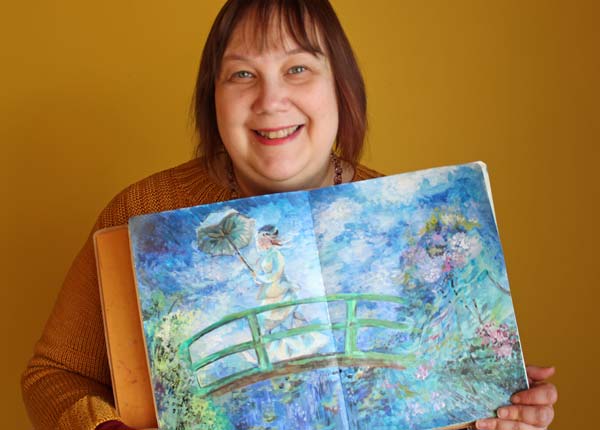
4 Published Mini-Courses, 2 More to Come
Alphonse Mucha, William Morris, Friedensreich Hundertwasser and Claude Monet have been my inspiration for this spring. When you sign up for Imagine Monthly, you will get all these 4 mini-courses right after the purchase and 2 more in the coming months.
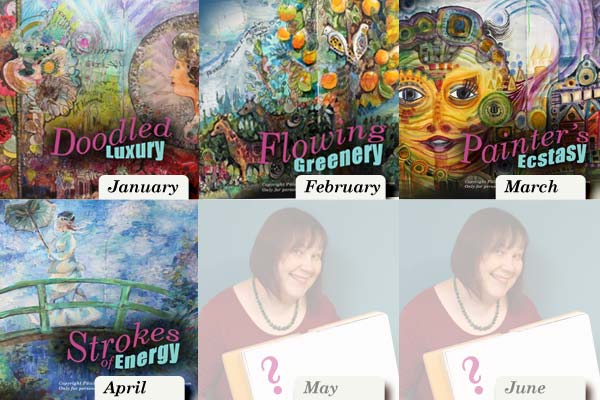
Also, you will get to be a part of a great community! Every week, when I look at the unique versions my students have made from the exercises, I am in awe. I feel extremely lucky to be part of the group and wish all those masters could still be alive and participate the conversation!
>> Imagine Monthly – Sign up here!
Step into Hundertwasser’s Ecstasy!
An Austrian architect and artist Friedensreich Hundertwasser inspired me to create this art journaling mini-course. Painter’s Ecstasy has just been released as a part of Imagine Monthly.
Getting into Hundertwasser’s Head
Creating the mini-course took a lot of time. I didn’t want to just paint something in Hundertwasser’s style. I wanted to find the elements in his style that support intuitive painting. I wanted to discover the essentials that allow anyone to produce their own work, not just copies. I also wanted to point out the most important nuances that make his paintings so appealing.
Even if Hundertwasser’s paintings (go check my Pinterest board: “Hundertwasser Hunger”) are so clearly shaped and striking, getting into his head wasn’t easy! I made a lot of sketches and experimented with various art supplies. These art journaling pages are some of the sketches:

Structures from Buildings and Maps
Hundertwasser’s education in architecture affected the way he painted. He used structures from buildings and maps to express himself. His paintings tell stories about how humans relate to their environment. It made me think how my desire to paint glassware and ceramics is due to my studies in industrial design. However, I truly enjoyed the techniques discovered from Hundertwasser’s paintings! I am definitely going to continue using those! It’s mostly just watercolor, isn’t it amazing?!

3 Months, 3 Artists
Each of the mini-course has now presented an artist. I must admit that I have been a bit selfish here, picking out artists that truly inspire myself. Luckily I have been blogging for a long time. It hasn’t probably been any surprise that January’s artist was Alphonse Mucha and February’s William Morris. But my love for Hundertwasser’s paintings might have been a bit hidden. Now when I have found out how he created his paintings, it won’t be a secret anymore!
Have Some Hundertwasser in Your Art Journal!
You can still hop on Imagine Monthly and get all the 3 mini-courses right after the purchase. There are three more mini-courses to come and the community is just wonderful to be in! It is so delightful to see everybody’s unique versions of the techniques shown in the class. Purchase here!
Create Doodled Luxury!
Happy New Year everyone! With the new year, a new class has started. Imagine Monthly is a series of 6 mini-courses, released one by one from January to June. Imagine Monthly is a bit different than my other online workshops. It has a slower pace and you can sign up even if the class is already running. January’s mini-course “Doodled Luxury” has just been released. You will get it right away after signing up!
Why This Course?
I wanted to start the series of 6 mini-courses by showing the potential of free hand drawing. For many, drawing is about being able to copy something realistic but there’s so much more that you can do with flowing lines. I think drawing should be redefined and enabled for everyone. It’s my mission to enable you to enjoy drawing and have a great time with your growing imagination! (Want to ponder more about the ability to draw? Read this blog post: “Can You Draw?”)
Creating with Luxury in Mind
When developing “Doodled Luxury”, I spent a lot of time thinking about the concept of luxury. I think it’s not just something to buy, it’s more about creating something unapologetic and self-sufficient. Something which makes you feel rich in a way that has very little to do with money.

While experimenting with the techniques used in “Doodled Luxury”, I created an art journal spread that summarizes the ideas that I had in my head: bringing a clear focal point, getting inspired by the many layers of luxurious clothes, letting quantity increase the quality.
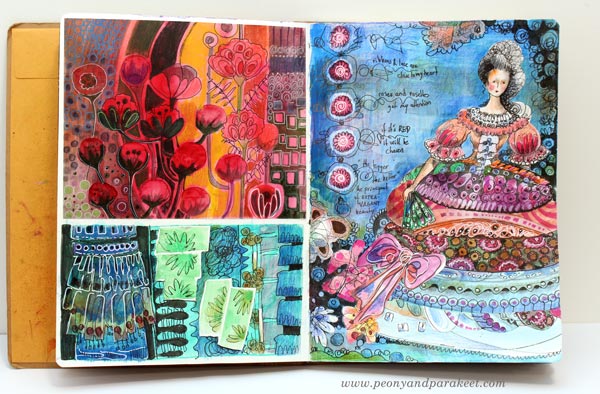
The spread above is just a background study for the course, but I wanted to show it as an example of how your art journal can contain “idea boxes” which in turn can lead to more advanced ideas like this one:
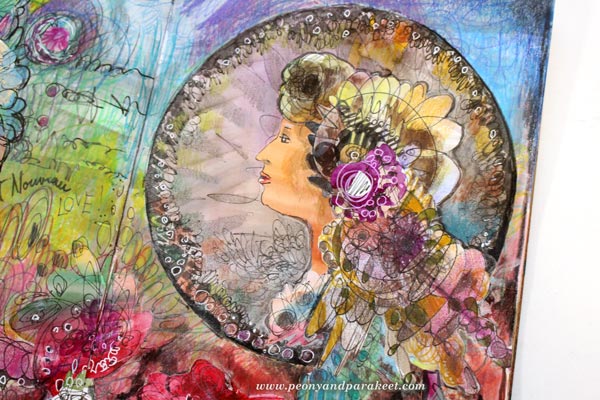
This Alphonse Mucha inspired collage has influences from Marie Antoinette’s period. Can there be anything more luxurious than art nouveau combined with rococo, expressed by hand-drawn elements? Doodling truly can produce luxury when there’s more than enough of it!
Experience the power of simple handdrawing and other easy techniques
Buy Imagine Monthly!
Why History, Computers and Art Belong Together
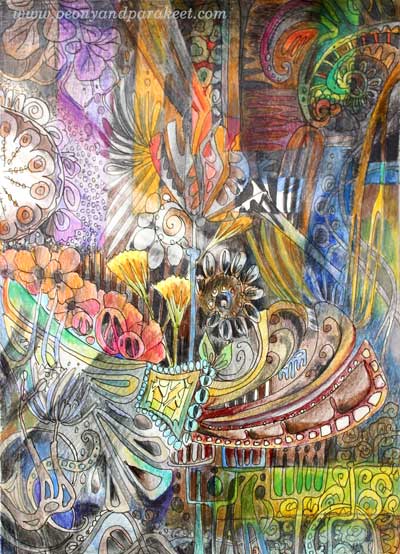
This art journal page is about two things that are close to me: art nouveau and computer engineering. With my background in technology, many find it surprising that historical styles like Art Nouveau fascinate me so much. And vice versa: why someone so interested in history, has studied and worked with computers.
Inspiring Periods of World History
For me, history, computers, and art have a natural connection. Think about the era of Art Nouveau: the end of 19th century and the beginning of 20th century. It was the era of the industrial revolution when many technical inventions were born. Also, at the same time, new kind of art was emerging. For example, Virginia Woolf wrote books using the stream of consciousness, Vincent van Gogh painted Starry Night, and Charles Rennie Macintosh designed a grand building for Glasgow School of Art. After inventing computers, we are experiencing another great era with a lot of innovations, the internet, and smartphones among others. I am certain that it will be seen as one of the most exciting time in the world history. We have new tools for art and design and we if any can use art to look at what the future could hold.
The Stream of Consciousness – Creating a Coloring Page
When I started to create the art journal page, I thought about the two eras and their similarities. With a black drawing pen, I began drawing art nouveau style shapes. It was exciting to think about modern things while drawing in the old style. It is very inspirational to stay focused on two things that have both similarities and differences.

It is relaxing to draw like imitating Virginia Woolf: using the stream of consciousness. Rotating the page makes it easier to keep the stream flowing.
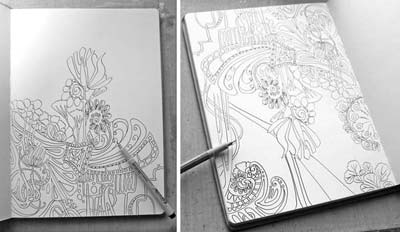
Coloring books seem to be popular at the moment. We art journalers can make our own! Here’s my page before coloring.
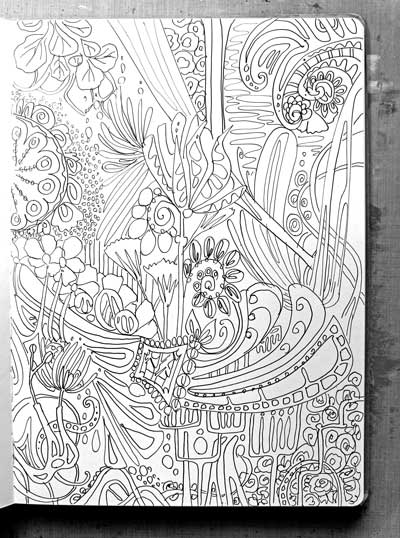
Past, Present, Future – Art Is an Equation
When I studied computer engineering, I had to understand a mathematical equation that was used widely to control technical systems. It was called Kalman filter and it was composed of three parts: past, present and future. I found the philosophy behind the equation most fascinating: to get better at what we do, we must understand the past, stay grounded to the present and be brave enough to predict the future.
Art can be our equation. We can use art to ponder on what has happened to us. We can use art to record the present. But most importantly: art can make us get off the ground. We can predict what the future will hold by taking old and current stuff and create new combinations. We can imagine what Virginia Woolf would do in the 22nd century and illustrate it. There are no limits and we already have most of the information.
That’s why I think that history, computers and art belong together. They are all parts of the same equation.
Adding New Dimensions by Coloring
To bring today’s graphic shapes to the work, I drew rectangular areas on the top of the drawing. Then I colored them with a different color scheme.

Finally, I expressed how past can bring us the future by erasing color with a light strokes. The light comes from the past. With the past, we can see the future.
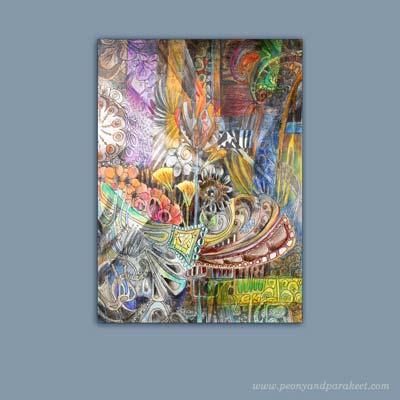
Tell me, what have you picked (or would like to pick) from the past to your art?
Create your own colored version of this page!
>> Buy Coloring Freely!
